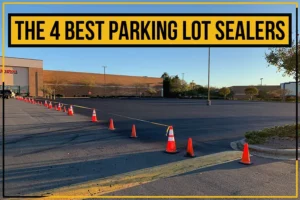Commercial paving projects like parking lots need wheel stops to keep vehicles from going over the edge of the lot. Installing wheel stops on asphalt or concrete pavement can be tricky, so working with someone experienced is essential.
In this article, Proline Parking Lot Maintenance, Inc. will walk you through wheel stop installation for a commercial parking complex.
Rubber Wheel Stops
Ensure the surface is flat, and estimate the distance necessary from the curb, wall, or edge. The installation position will differ if the wheel stop is front to curb or rear to curb.
Asphalt
For asphalt pavement, you’ll need:
- a hammer
- Three fixing pins at 13mm diameter and length of 360mm with a 20mm head
- an epoxy fitted into a caulking gun
First, drill a guide hole of 12mm through the stop and into the surface of your commercial pavement. Stop at a depth of 100mm. Next, gun a liberal bead of epoxy into the hole. Lastly, line up the fixing pins and hammer them through the wheel stop and into the asphalt pavement.
Concrete
Grab the following:
- a hammer drill with a 12mm masonry bit and 16mm socket
- Three galvanized hex head screw bolts at a diameter of 12mm and length of 150mm.
Using the hammer drill, make a guide hole into the concrete paving. Brush away any concrete dust. Reach for your screw bolts and secure them through the wheel stop and into the drilled holes using your 16mm socket. Your commercial pavement wheel stop is now ready for use.
Concrete Wheel Stops
Similarly, you’ll need the wheel stop and the relevant PPE along with the following tools to install the wheel stops:
Asphalt
For asphalt paving, you’ll need:
- Two fixing pins at a head of 20mm, with a diameter of 13mm and a length of 360mm
- Epoxy in a caulking gun if necessary
Using the steps mentioned earlier for the rubber wheel stops, determine the position your wheel stop will take on your commercial pavement. Using a lifting sling, place the wheel stop where it belongs on the flat surface. After creating your guide hole, gun the epoxy into it, and hammer the fixing pins through the wheel stop and into the asphalt pavement.
Concrete
For a concrete wheel stop on concrete pavement, you’ll need:
- a hammer drill with a 12mm masonry bit and 16mm socket
- Two galvanized hex head screw bolts at measurements of 12mm diameter by 150mm length
After determining the position of the wheel stop on your commercial paving, drill a 12mm guide hole at a depth of 100mm through the wheel stop and into the concrete paving. Once you’ve brushed away the dust, secure the screw bolts through the stop into the holes using the 16mm socket.
Conclusion
Installing wheel stops is essential for ensuring the safety of both drivers and pedestrians. The job may seem daunting, but with the help of the experts at Proline Parking Lot Maintenance, Inc., it doesn’t have to be.
As the greater Charlotte area’s #1 pavement maintenance company, we offer reliable, professional service. Come to us for all your commercial paving needs in Huntersville, NC – from asphalt paving to concrete paving.










